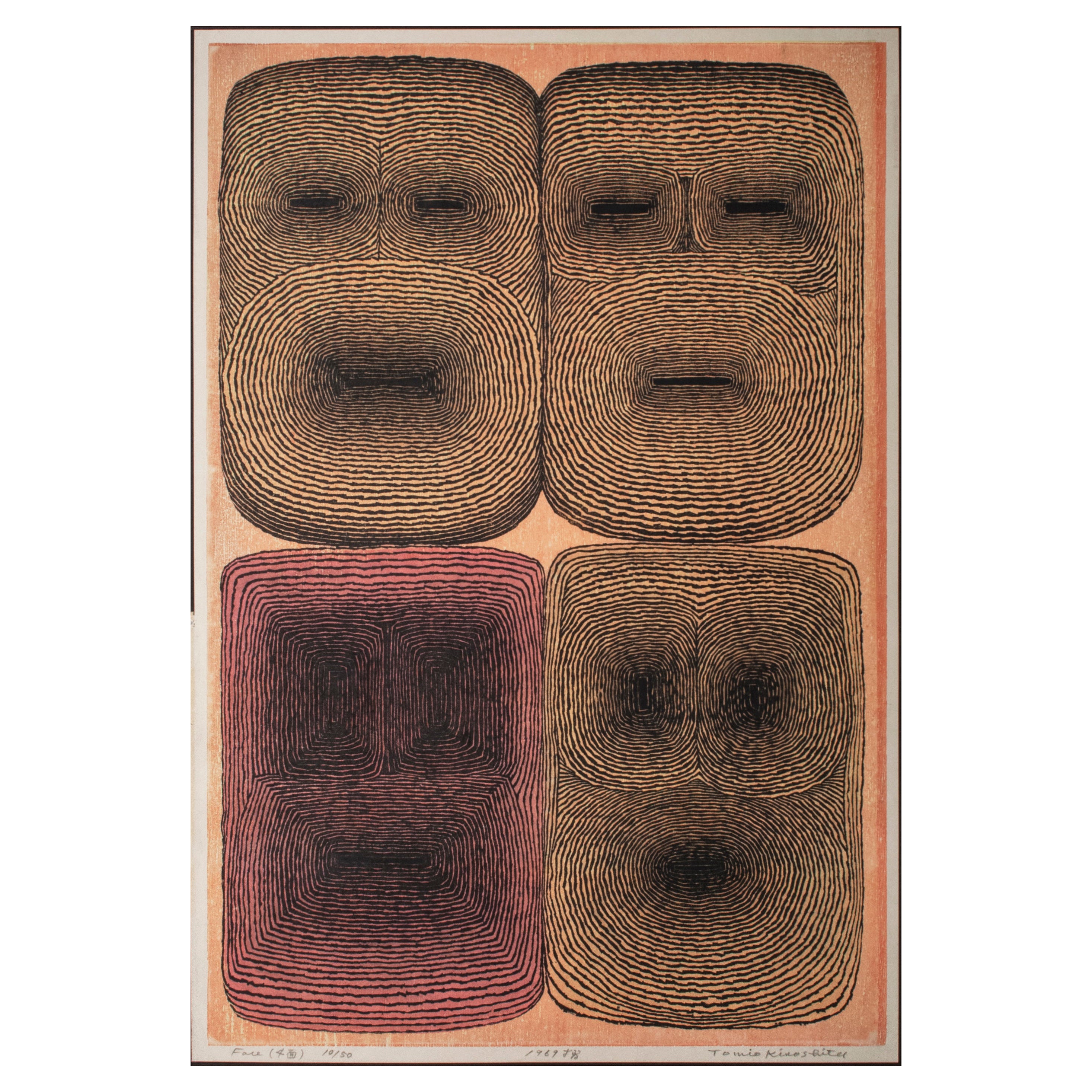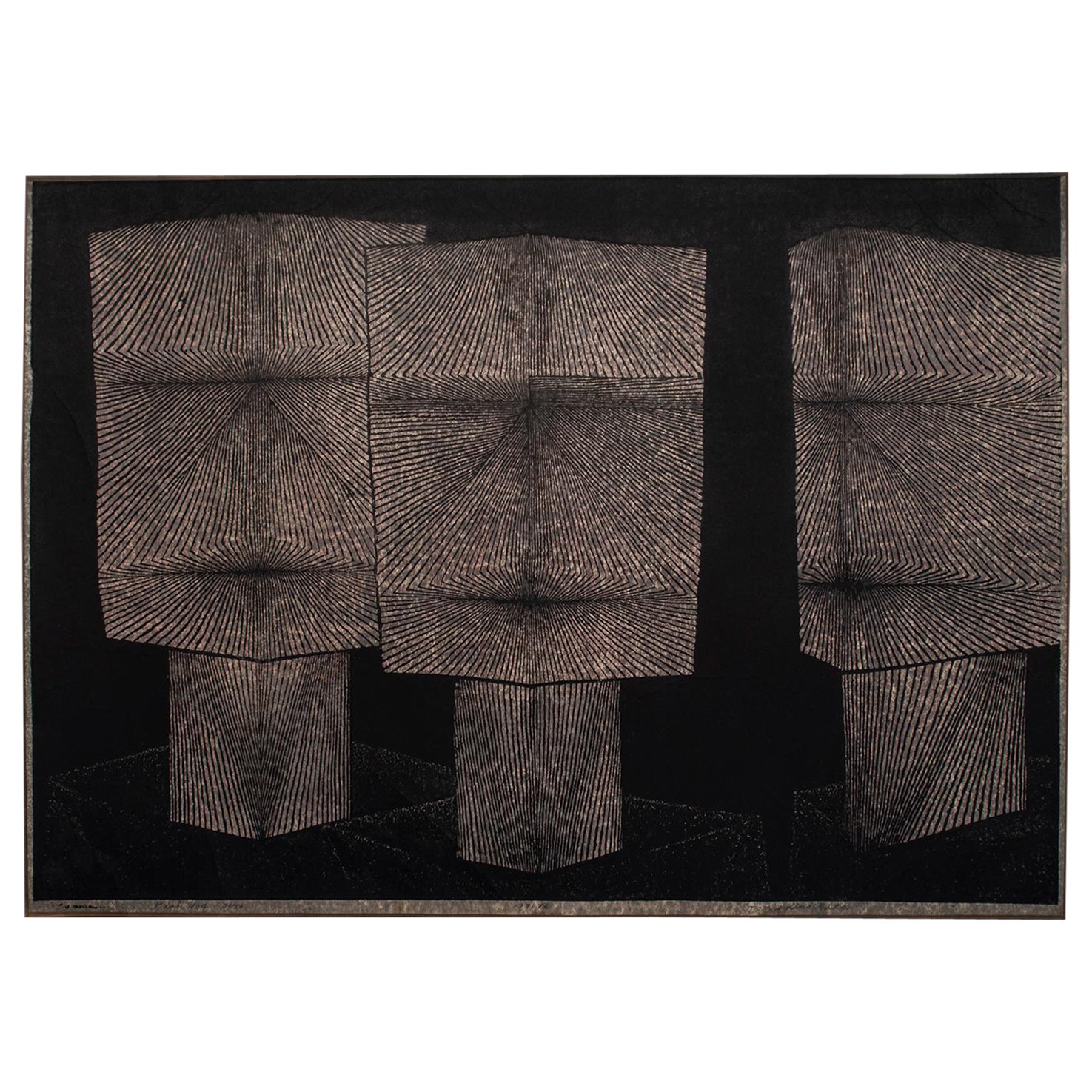Items Similar to Original Japanese Woodblock Print of a Warrior by Gyokusei Tsukioka 月岡 玉瀞
Want more images or videos?
Request additional images or videos from the seller
1 of 8
Original Japanese Woodblock Print of a Warrior by Gyokusei Tsukioka 月岡 玉瀞
About the Item
Original Japanese woodblock print by Gyokusei Tsukioka (1908-1994): a warrior (samurai) from the series ‘Noh Play Prints of the Hosho School’ (Hosho-ryu Noh Gaku Hanga).
An actor donning a ferocious mask is clad in an impressive and ornately decorated full samurai kimono (kamishimo), has a katana (sword) drawn in his right hand and is holding the other hand above its head.
Date: Around 1930
Type: Shin Hanga
Format: Oban
Sealed in front: Gyokusei
Signed and sealed at the back.
Tsukioka Gyokusei, the daughter of the artist Tsukioka Kogyo (1869-1927), was born in Tokyo in 1908 with the given name of Fumiko. Her married name was Inada Fumiko. She studied at the Women’s Specialist School of Fine Arts, graduating in 1929, and she studied Japanese-style (yamato-e) painting with Matsuoka Eikyu (1881-1938), who worked to revitalize and modernize yamato-e. Like her father she specialized in representations of Noh drama.
When shipped we will add a certificate of authenticity.
Price including insured shipping.
- Creator:Gyokusei Tsukioka (Artist)
- Dimensions:Height: 14.85 in (37.7 cm)Width: 10.12 in (25.7 cm)Depth: 0.04 in (1 mm)
- Materials and Techniques:Paper,Other
- Place of Origin:
- Period:
- Date of Manufacture:circa 1930
- Condition:In a very good original condition. Please look at the photos for a condition reference.
- Seller Location:Amsterdam, NL
- Reference Number:
About the Seller
5.0
Vetted Seller
These experienced sellers undergo a comprehensive evaluation by our team of in-house experts.
Established in 1996
1stDibs seller since 2022
16 sales on 1stDibs
Typical response time: 10 hours
- ShippingRetrieving quote...Ships From: Amsterdam, Netherlands
- Return PolicyA return for this item may be initiated within 14 days of delivery.
More From This SellerView All
- Original Japanese Woodblock Print of Playing Children by Katsukawa Shunsen 勝川春扇By Katsukawa ShunsenLocated in Amsterdam, NLOriginal Japanese woodblock print by Katsukawa Shunsen (Shunko II) (1762- circa 1830): five karako (Chinese boys) in traditional garments at play in a snow covered garden, making an ...Category
Antique 1810s Japanese Prints
MaterialsPaper
- Japanese low 2-panel byôbu 屏風 of a dragon by Shioya Shinsen 塩谷深仙Located in Amsterdam, NLStriking low two-panel byôbu (folding screen) with a detailed painting of a dragon (ryû) leaping up from the sea holding a flaming pearl in his claws. He flies towards the rough sky,...Category
Late 20th Century Japanese Paintings and Screens
MaterialsMetal
- Japanese screen with a painting of an large elephant & monkey by Mori Kanson 森間村Located in Amsterdam, NLA marvellous, tall six-panel byôbu (folding screen) with a rare painting of a large white elephant standing under a blooming paulownia tree (kiri), with a monkey sitting on the ear o...Category
Antique 19th Century Japanese Paintings and Screens
MaterialsMetal
- Rare, Japanese Kyûshû 九州 ishô’dansu 衣装箪笥 (chest of drawers)Located in Amsterdam, NLRare and richly adorned wooden Kyûshû ishô'dansu (cabinet of drawers) in a single section, on a plinth. Fully restored, cleaned and waxed. The drawer faces are made of indigenous k...Category
Antique Late 19th Century Japanese Furniture
MaterialsIron
- Outstanding Japanese Biomorphic Abstract Sculpture by Harumi Nakashima 中島晴美By Harumi NakashimaLocated in Amsterdam, NLOutstanding and large porcelain biomorphic abstract sculpture covered in clear glaze and regularly distributed opulent cobalt blue polka dots of varying sizes, titled ‘Twisting Back, Multiplying’, hand-built by the highly praised Japanese ceramic artist Harumi Nakashima (1950). Signed at the bottom in a dot '1104 Haru'. Made in 2011. Documented on the website of the artist himself. Born in 1950 in Ena, Gifu Prefecture, Harumi Nakashima is known for his biomorphic porcelain sculptures decorated with opulent blue dots. He excels in clay creations far removed from both tradition and functionality. Taking great care to achieve a flawless surface and form, each piece is created over the course of six months. Nakashima's early reputation was cemented as one of the leading teachers at the Tajimi Pottery Design and Technical Center, having trained and influenced many of the promising young ceramicists of Japan since 1976. Nakashima has received leading prizes and tributes. With works collected by 20 public institutions the world over, including the Museum of Arts and Design in New York and the Faenza Ceramics Museum in Italy, he is one of Japan's most celebrated porcelain artist. Influenced by the blue sometsuke (under-glaze) motifs of traditional Japanese porcelain, Nakashima's motifs also use cobalt blue over-glaze. Yet unlike traditional methods, Nakashima's blue dots are painted over the body of a work after the main firing, and then fired into the white glaze of the porcelain with a second firing using the technique of "in-glazing", thereby leading to the sinking of the dots upon the white overglaze. Perhaps more surprising is the fact that his organic, sprawling and fluid porcelain bodies are entirely hand-built. As porcelain is extremely difficult to manipulate by free-hand, Nakashima intentionally uses this method to create not only tension, but an epic "battle with clay". He is currently based in the port city of Nagoya, and some of his more recent exhibitions are; 2021 Art Market San Francisco, Duane Reed Gallery...Category
2010s Japanese Ceramics
MaterialsPorcelain
- Heavy, Japanese bronze temple bell 梵鐘 (bonshô) of traditional shapeLocated in Amsterdam, NLHeavy bronze temple bell (bonshô) of traditional shape with an appealing echoing sound when struck. Its surface is a rich brown, complemented by a hint of light green aged patina. ...Category
Mid-20th Century Japanese Metalwork
MaterialsBronze
You May Also Like
- Japanese Color Woodblock Print by Toyohara ChikanobuBy Toyohara ChikanobuLocated in New York, NYThis Meiji-period color woodblock by Toyohara Chikanobu (1838-1912) depicts three elegant female courtiers in traditional dress taking refreshments. Th...Category
Antique Late 19th Century Japanese Meiji Prints
MaterialsPaper
- 1969 Graphic Woodblock Print by Tomio Kinoshita, JapanBy Tomio KinoshitaLocated in Point Richmond, CAFaces (4 Faces), 1969 Tomio Kinoshita (1923-2014), Japan Woodblock print Paper, pigment, sumi ink Image: 27 high by 18.25 inches wide (68.5 by 46.4 cm) Paper size: 28 high by 19...Category
Vintage 1960s Japanese Mid-Century Modern Prints
MaterialsPaper
- 1981 Graphic Woodblock Print by Tomio Kinoshita, JapanBy Tomio KinoshitaLocated in Point Richmond, CATomio Kinoshita (1923 - 2014) Masks (No. 4), 1981 Woodblock print Image Size: 22 high by 31 inches wide (56 by 79 cm) Paper Size: 22.75 high by 31.5 inches wide (57.8 by 80 cm) ...Category
Vintage 1980s Japanese Mid-Century Modern Prints
MaterialsPaper
- 1960 Big Boys, Woodblock Print by Tomio Kinoshita, JapanBy Tomio KinoshitaLocated in Point Richmond, CATomio Kinoshita (1923 – 2014) Big Boys, 1960 Woodblock print Image size: 32.75 high by 22 inches wide (83 by 56 cm) Paper size: 35.5 high by 23.75 inches wide (90 by 60.3 cm) Signed: in pencil lower right, Tomio Kinoshita Titled: in pencil at lower left Edition: 30/50 Condition: Very good The woodblock for this large print was carved in 1958, just three years after Kinoshita’s began creating woodblocks. This print was signed and dated in 1960, but not numbered; prints were also pulled from this block in the 1970s, so it must have been one of more popular images. One of his students has written, “As time progressed further, the postwar era saw improvements in nutrition, and children became taller and heavier than in the past, but their lack of physical exercise and severely inferior physical abilities became a social problem; this is ironically depicted in Big Boys.” In 1963, Kinoshita told him that he had just finished pulling a print of this image in response to a request from Unichi Hiratsuka...Category
Vintage 1960s Japanese Mid-Century Modern Prints
MaterialsPaper
- Antique Japanese Woodblock Print of a Samurai, 19th CenturyLocated in Lambertville, NJA vibrant antique Japanese wood block print of a samurai. The block print with broad sage green mat with ebonized Asian style frame with UV Glass. M...Category
Antique 19th Century Japanese Meiji Prints
MaterialsArt Glass, Hardwood, Paper
- 1965 Face 'Black', Woodblock Print by Tomio Kinoshita, JapanBy Tomio KinoshitaLocated in Point Richmond, CATomio Kinoshita (1923 – 2014) Face (Black), 1965 Woodblock print Image size: 25 high by 18 inches wide (63.5 by 45.7 cm) Paper size: 26.25 high by 19 inches wide (66.7 by 48.2 cm) Unsigned Condition: some wrinkling in the margins This print is from a woodblock that was carved in 1965; Kinoshita would often experiment with colors and sometimes not sign the test prints. A green and black version of this image can be found in volume one of the two-volume 44 Modern Japanese Print Artists by Gaston Petit...Category
Vintage 1960s Japanese Mid-Century Modern Prints
MaterialsPaper
Recently Viewed
View AllMore Ways To Browse
1930 Japan
Vintage Japanese Woodblock
Vintage Japanese Woodblock Prints
Japan Mask
Japanese Kimono Print
Japanese Kimono Prints
Japanese Warrior
Japanese Sword Furniture
Asian Warrior
Asian Samurai Art
Asian Sword
Swords Asia
Vintage Japanese Samurai
Samurai Warrior
Mask Warrior
Noh Mask
Original Japanese Kimono
Japanese Painting Women





